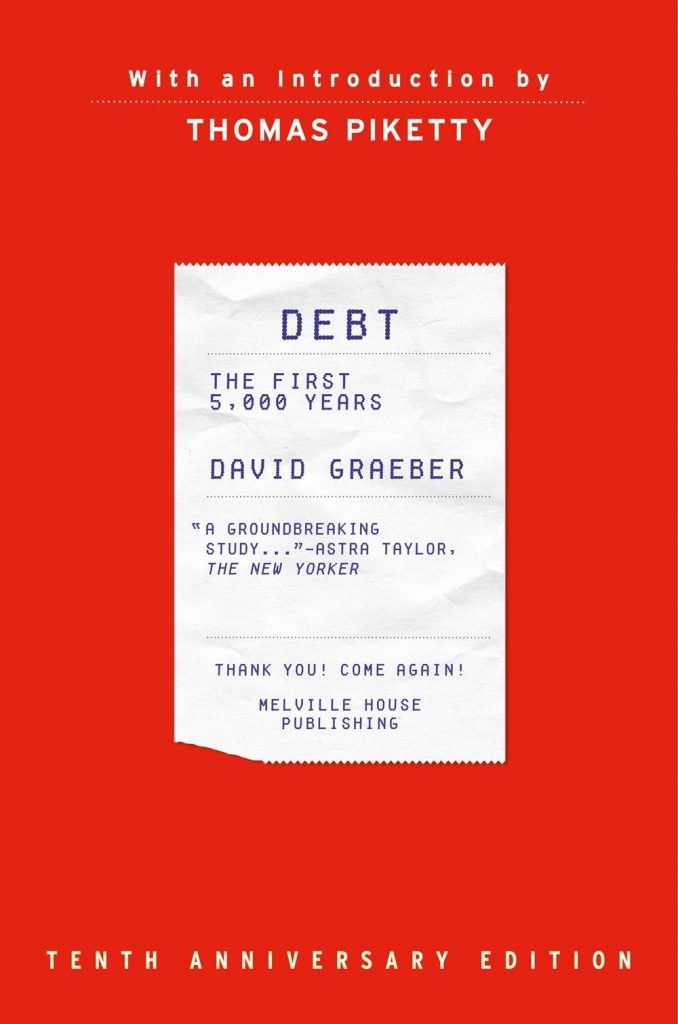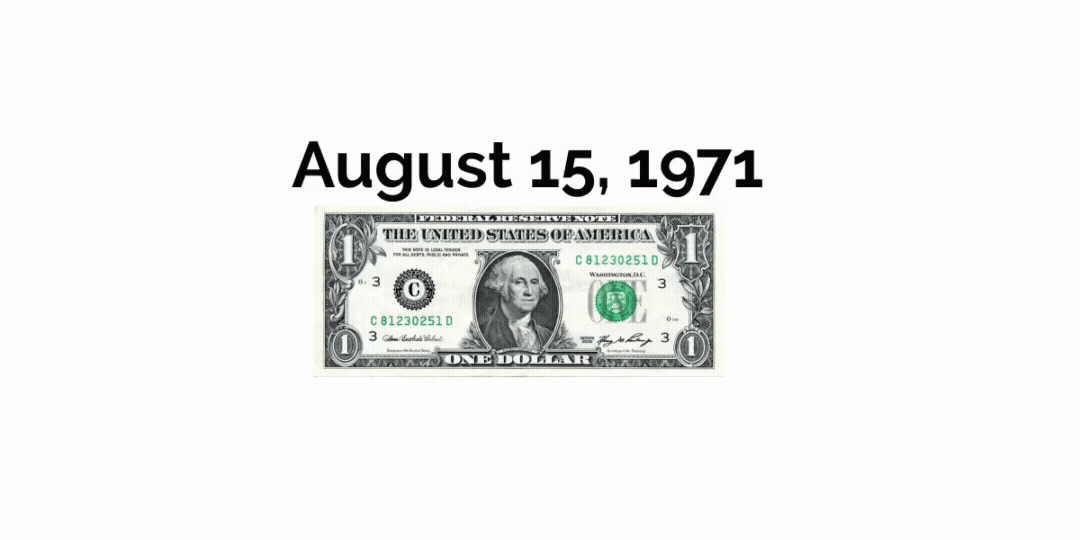
On August 15, 1971, President Richard Nixon permanently shut the gold convertibility window and severed any connection of the U.S. Dollar to a tangible value-based monetary system. In this article we will look at that fateful day in monetary history, what we have learned from it after a 50-year experiment, and explore the three different monetary systems that have existed throughout history to evaluate what is the best way to protect your purchasing power moving forward.
With five decades of Fiat history behind us, we can look at the great fiat experiment with the hopes of better understanding the problems and bottlenecks that it creates for citizens. As we approach the 50 year anniversary of Nixon decoupling the U.S. Dollar from Gold, traders and investors should either watch the video of his speech announcing the nations new economic policy, or study the transcript. In so doing, you can make your own conclusions of how Fiat was sold to the nation and the world.
To appreciate how The United came off the Gold Standard, you have to understand the tumultuous nature of the 1960’s. The United States had a very expensive war in Vietnam. It was engaged in exponentially increasing social spending through President Johnson’s Great Society programs, while simultaneously engaged in the Cold War with the Soviet Union and funding the NASA space program. Nations around the world were very aware of how much the United States was spending on these costly programs and became very nervous about having their debts repaid by the United States in inflated dollars. So, throughout 1971 a growing number of countries began to settle their transactions with the United States for Gold Bullion. French President deGaulle demanded Gold Bullion delivery from the United States and sent a warship to a New York Harbor with instructions to bring back its gold from the New York Federal Reserve.
On August 15, 1971, a Sunday Evening, President Nixon addressed the Nation in a speech titled “The Challenge of Peace.” Within his speech, he positioned the reason for severing the U.S. dollar’s convertibility to Gold as something the Nation had to do in its pursuit of Peace as he sought to remove The United States from the war in Vietnam and blamed the “international speculators” for the devaluation that was occurring in the currency.
Anybody younger than 50 years of age has only known the Fiat Currency system. Surprisingly, when Nixon severed the U.S. Dollar from Gold it went relatively unnoticed. Most people did not comprehend it, but the shockwaves have been felt around the world ever since.
A few important economic factors were said in the speech:
“America today has the best opportunity in this century to achieve two of its greatest ideals: to bring about a full generation of peace, and to create a new prosperity without war.”
Next, Nixon proposed this new prosperity would stop the rise in the cost of living by mandating that all wages and prices be frozen for 90 days:
“Working together, we will break the back of inflation, and we will do it without the mandatory wage and price controls that crush economic and personal freedom.”
Lastly, President Nixon decided what was needed to create this prosperity was to temporarily suspend the convertibility of the U.S. Dollar with Gold.
“I have directed Secretary Connally to suspend temporarily the convertibility of the American dollar except in amounts and conditions determined to be in the interest of monetary stability and in the best interests of the United States.”
Fifty years later, the “temporary” suspension is still in place. Since the “Nixon Shock” we have seen perpetual wars as the printing press can fund conflicts indefinitely. And perpetual inflation is what citizens expect as Fiat has proven to be a horrible store of value.
Maybe, I’ve just watched a little bit too much of Championship Poker, but at key points in his speech, President Nixon did what Poker players would refer to as a “tell.” He nervously rubbed his nose, which among poker players standards, sneaking a nose touch indicates masked tension and stress. It’s a nonverbal way of saying, “Everything is OK!” (but everything might actually NOT be OK).
Then again, maybe his nose just itched!

After fifty years of this great experiment in Fiat, there are several things we can conclude…
$1.00 in 1971 would have to be worth $6.51 today for it to have maintained its purchasing power. This value is calculated by simply looking at official government Consumer Price Index Statistics. This means that today’s prices are 6.51 times higher than average prices since 1971, according to the Bureau of Labor Statistics consumer price index. A dollar today only buys 14% of what it could buy back then. Is it any wonder that top hedge fund manager, Ray Dalio often quips that “cash is trash.”?
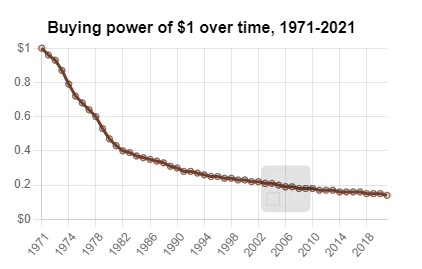
The COST of LIVING exploded higher from this day forward. Wages have never kept up with price increases.
Keep in mind that many of the current price of the items in the graphic below are much more than 6.51 times higher.
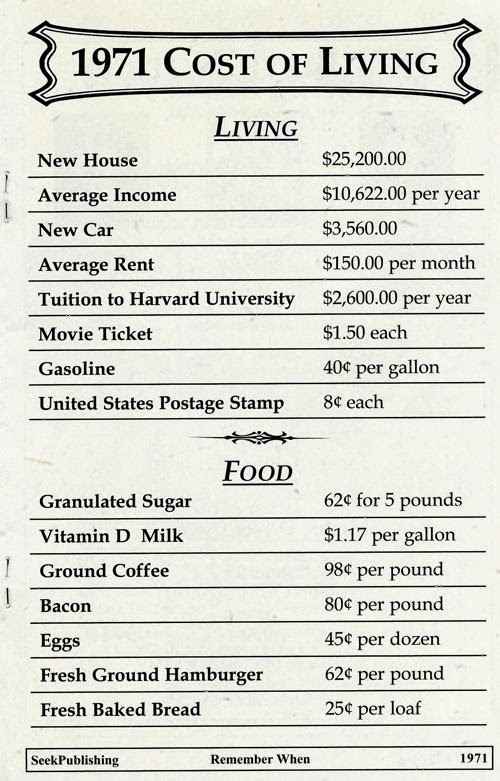
Federal Debt and Deficit Spending exploded higher.
The appeal of a gold standard is that it arrests control of the issuance of currency out of the hands of imperfect human beings or politicians. The physical quantity of gold acts as a limit to the issuance of new currency, as governments know that there are consequences to spending money that they do not have.
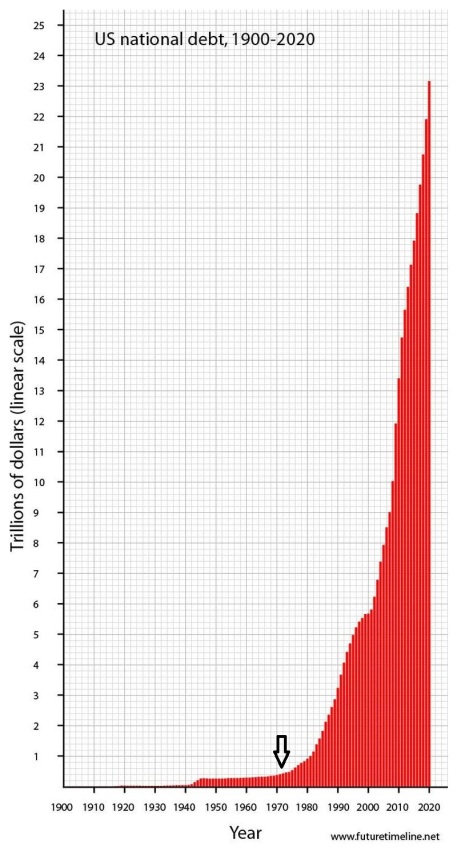
Inflation clearly broke out on the long-term chart and built its foundational roots in the monetary policies which started in 1971.
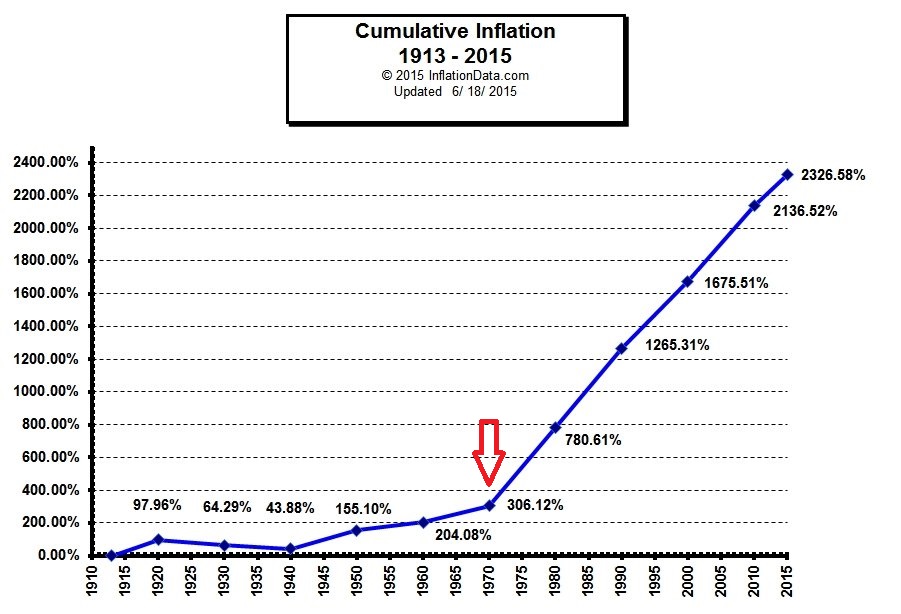
Federal Debt as a % of GDP became the key driver of how economic progress was accomplished and defined.
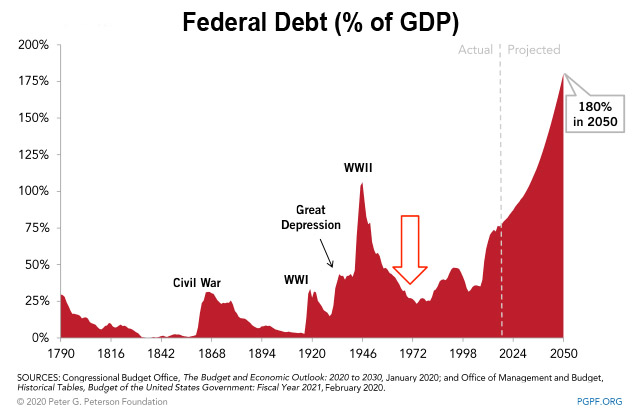
What is most troubling about this chart is that for the last 50 years the government has been spending $4 to get $1 worth of GDP. Meaning that debt is growing four times faster than the economy. The government narrative for the last 50 years has been that the government will spend the money now. The spending will create new wealth that will also create new taxable opportunities in the future which will result in the debt burden being repaid in the future. But when you spend $4 and only get $1 production the deficit can only increase exponentially, and you can’t tax the public enough to repay the debt burden let alone the interest on the debt.
As we reflect on all the economic and price changes which have occurred in the past five decades, we should also spend some time understanding and evaluating the competing monetary systems which exist in the world.
For the last 50 years Fiat has ruled the economic order. The word “fiat” means by decree and what it means is that something is valuable and must be accepted as legal tender because the government passes laws requiring all citizens to use it in computing wages and trade. In all fiat economies the base layer of the currency is debt.
A great book which thoroughly describes the history of this monetary system was written by David Graeber and is titled, “Debt, The First 5,000 Years.”
Fiat money is a government-issued currency that is not backed by a commodity such as gold. Fiat gives central banks greater control over the economy because they can control how much money is printed. Most modern paper currencies, such as the U.S. dollar, are fiat currencies. The best concise summary of fiat that I have ever come across was stated by former Fed Chairman, Ben Bernanke, where he assured listeners at a Senate testimony that:
“The U.S. government has a technology, called a printing press (or today, its electronic equivalent), that allows it to produce as many U.S. dollars as it wishes at no cost.”
Clearly the printing press places the government’s role in the economy front and center as the steward of economic progress in a fiat monetary system.
The second type of monetary system is commodity-based money. This can be something like a gold standard, but it is a monetary unit of account that could be cattle, pigs, chickens, rice, eggs, cigarettes, or anything which people deem to be of value. Ideally the commodity which is to be used as money needs to be scarce and difficult to produce, otherwise people will mass produce the commodity and it will no longer retain value. Historically, commodity based monetary systems would usually replace fiat based monetary systems whenever citizens lost faith in the currency that the government was printing.
For example, in prisons, the form of money which is created by inmates is cigarettes. However, when cigarettes become easy to produce in prison, this currency no longer maintains its value.
These commodities are tangible in nature and possess intrinsic value. Commodity money derives its value from the commodity of which it is made, while fiat money has value only by the order of the government. The value of commodity money comes from the commodity out of which it is made. The commodity itself constitutes the money, and the money is the commodity.
Most modern monetary systems have been based on fiat money. However, for most of history, almost all money was commodity money, such as gold and silver coins.
But there is one monetary system which most people are unfamiliar with, and it too has existed for thousands of years. It is referred to as the open ledger monetary system. You are probably not familiar with the island of Yap in Micronesia. But hundreds of years ago Yapese voyagers rowed outrigger canoes to limestone quarries in Palau. Then they rowed the same canoe back over 300 miles with these one-ton giant stones on board their small canoes. This process was dangerous, time consuming, and required intense amounts of human labor. Once the stone arrived on the island, the owner of the stone would use it as a payment method, and everyone in the community would know the ownership had been transferred to a new owner. This monetary system worked amazingly well on Yap till 1871 when European explorers discovered that they could inflate the money supply and easily bring in new stones to the island and exchange them for real goods and services the Yapese were producing. Stone money worked as a public ledger which was acknowledged and respected by everyone in the community. However, when the “new stones” were introduced onto the island by European explorers the Yapese no longer trusted the money that had worked well for many generations on the island. In other words, the European explorers introduced inflation on to the island.
While this monetary system is very primitive sounding, it is exactly what modern cryptocurrencies like Bitcoin have sought to emulate. These giant public stones are the foundation of blockchain and public accountability which cryptocurrency brings about. The Yapese culture created a transparent public ledger where everyone knew who owned which stones and the stones retained their value through the public commerce that was engaged surrounding them.

Why is this important?
All of these monetary systems are competing for primacy in today’s world. Investors need to decide for themselves where they can find their best store of value.
It is not an easy challenge to respond to. Fiat has been around for thousands of years and is central to the current economic order. Gold also has a history of thousands of years and historically has proven to be a wonderful hedge against inflation and calamity. The new kid on the block, Bitcoin, has only been in existence for 12 ½ years. So, we can only compare monetary system performance based upon this time frame and in so doing, Bitcoin has exponentially outperformed all other assets.
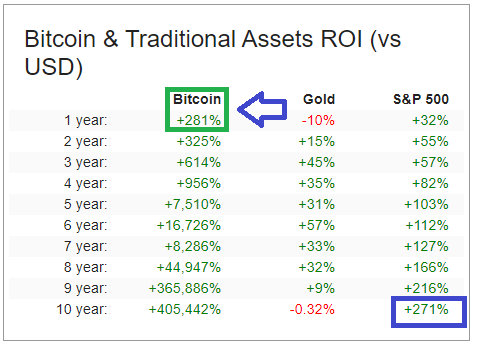
As a matter of fact, you can see that bitcoin over the past year at +281% has outperformed the S&P 500’s +271% performance of the last decade. But then again it is only 12 ½ years old.
Will this continue? Difficult to say on opinion alone.
And that is exactly why I use artificial intelligence and machine learning to guide with my investment and decision-making processes.
Readers of this blog are keenly aware I have communicated some skeptical things about the current economy and the state of the stock market. But I have never let those perspectives get in the way of the reality that the stock market has been in a solid uptrend for the past 17 months. I refer to this as recognizing the difference between prognosticating what “SHOULD” happen and being in tune with what “IS” occurring.
When “IS” and “SHOULD” meet some pretty explosive things can happen and that is where we want to be as traders. Stories are a nickel a dozen. Today traders are rewarded for their ability to quantitatively understand what the trend and risk are for any trade they are about to make.
Therefore A.I. and machine learning are invaluable. My experience has been that there is no better tool to keep me on the right side of the right trend at the right time than artificial intelligence.
As a trader one of the most important realizations you will have is recognizing you need to be tuned in to the PRICE ACTION and REAL DRIVERS that are affecting the markets you are trading. That is rarely portrayed in the form of reporters’ stories about what they think is happening in the economy, the market you are trading and the world. Since we live in a global marketplace the critical factors that affect a trader’s portfolio lie in recognizing and understanding the key drivers of an assets price. All markets are statistically correlated in some manner. Artificial intelligence, machine learning, and neural networks focuses exclusively on these relationships to create very accurate forecasts.
Most traders constantly bewilder themselves by trying to relate the top news stories to their trading decisions. As an example, try to explain how in the past year Gold has lost 10% of its value based upon all the crises that have been occurring.
Do you ever read the headlines in the media and wonder how it is going to affect your trading?
- COVID-19
- Trade War with China
- New Government Regulations
- Unemployment Forecasts
- Currency Instability
- Debt Growth
- Recession Concerns
- Negative Interest Rates
How do you make sense of it all? How does it affect your portfolio?
And let me know, do you think President Nixon was just itching his nose, or did he know that he was releasing a great fiat experiment upon the world that would devalue the dollar by over 86% in the last 50 years?
The challenge facing every trader is trying to make sense of the tsunami of financial information to make better trading decisions.
Quite a challenge!
That is why successful traders use artificial intelligence to find the best markets and the best time to trade.
Artificial Intelligence is not a would-be-nice-to-have tool. It is a must-have tool for today’s quickly changing financial landscape.
Your assets… your savings… your retirement… everything you have worked so truly hard for… they do not have to be at risk any longer.
Artificial Intelligence is no longer just for the large Wall Street Mutual Funds and ultra-wealthy. Today small traders are getting big results because of A.I.
Intrigued? Join us for a Free Live Online Training Lesson.
Discover why artificial intelligence is the solution professional traders go-to for less risk, more rewards, and guaranteed peace of mind.
It’s not magic. It’s machine learning.
Make it count.
IMPORTANT NOTICE!
THERE IS SUBSTANTIAL RISK OF LOSS ASSOCIATED WITH TRADING. ONLY RISK CAPITAL SHOULD BE USED TO TRADE. TRADING STOCKS, FUTURES, OPTIONS, FOREX, AND ETFs IS NOT SUITABLE FOR EVERYONE.
DISCLAIMER: STOCKS, FUTURES, OPTIONS, ETFs AND CURRENCY TRADING ALL HAVE LARGE POTENTIAL REWARDS, BUT THEY ALSO HAVE LARGE POTENTIAL RISK. YOU MUST BE AWARE OF THE RISKS AND BE WILLING TO ACCEPT THEM IN ORDER TO INVEST IN THESE MARKETS. DON’T TRADE WITH MONEY YOU CAN’T AFFORD TO LOSE. THIS ARTICLE AND WEBSITE IS NEITHER A SOLICITATION NOR AN OFFER TO BUY/SELL FUTURES, OPTIONS, STOCKS, OR CURRENCIES. NO REPRESENTATION IS BEING MADE THAT ANY ACCOUNT WILL OR IS LIKELY TO ACHIEVE PROFITS OR LOSSES SIMILAR TO THOSE DISCUSSED ON THIS ARTICLE OR WEBSITE. THE PAST PERFORMANCE OF ANY TRADING SYSTEM OR METHODOLOGY IS NOT NECESSARILY INDICATIVE OF FUTURE RESULTS. CFTC RULE 4.41 – HYPOTHETICAL OR SIMULATED PERFORMANCE RESULTS HAVE CERTAIN LIMITATIONS. UNLIKE AN ACTUAL PERFORMANCE RECORD, SIMULATED RESULTS DO NOT REPRESENT ACTUAL TRADING. ALSO, SINCE THE TRADES HAVE NOT BEEN EXECUTED, THE RESULTS MAY HAVE UNDER-OR-OVER COMPENSATED FOR THE IMPACT, IF ANY, OF CERTAIN MARKET FACTORS, SUCH AS LACK OF LIQUIDITY. SIMULATED TRADING PROGRAMS IN GENERAL ARE ALSO SUBJECT TO THE FACT THAT THEY ARE DESIGNED WITH THE BENEFIT OF HINDSIGHT. NO REPRESENTATION IS BEING MADE THAT ANY ACCOUNT WILL OR IS LIKELY TO ACHIEVE PROFIT OR LOSSES SIMILAR TO THOSE SHOWN.


